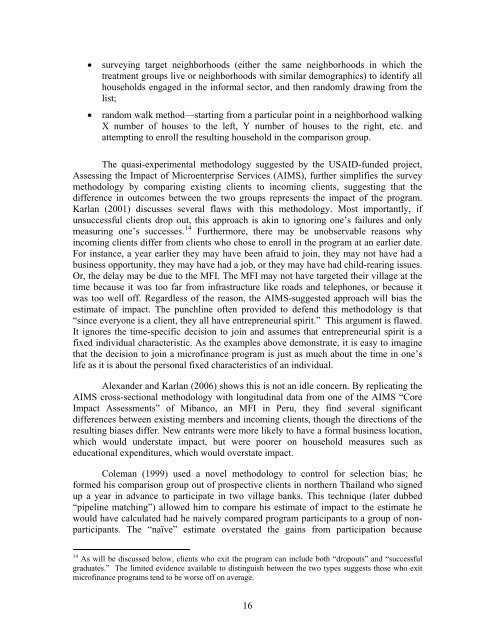Impact Evaluation for Microfinance: Review of Methodological Issues
Impact Evaluation for Microfinance: Review of Methodological Issues
Impact Evaluation for Microfinance: Review of Methodological Issues
Create successful ePaper yourself
Turn your PDF publications into a flip-book with our unique Google optimized e-Paper software.
• surveying target neighborhoods (either the same neighborhoods in which the<br />
treatment groups live or neighborhoods with similar demographics) to identify all<br />
households engaged in the in<strong>for</strong>mal sector, and then randomly drawing from the<br />
list;<br />
• random walk method—starting from a particular point in a neighborhood walking<br />
X number <strong>of</strong> houses to the left, Y number <strong>of</strong> houses to the right, etc. and<br />
attempting to enroll the resulting household in the comparison group.<br />
The quasi-experimental methodology suggested by the USAID-funded project,<br />
Assessing the <strong>Impact</strong> <strong>of</strong> Microenterprise Services (AIMS), further simplifies the survey<br />
methodology by comparing existing clients to incoming clients, suggesting that the<br />
difference in outcomes between the two groups represents the impact <strong>of</strong> the program.<br />
Karlan (2001) discusses several flaws with this methodology. Most importantly, if<br />
unsuccessful clients drop out, this approach is akin to ignoring one’s failures and only<br />
measuring one’s successes. 14 Furthermore, there may be unobservable reasons why<br />
incoming clients differ from clients who chose to enroll in the program at an earlier date.<br />
For instance, a year earlier they may have been afraid to join, they may not have had a<br />
business opportunity, they may have had a job, or they may have had child-rearing issues.<br />
Or, the delay may be due to the MFI. The MFI may not have targeted their village at the<br />
time because it was too far from infrastructure like roads and telephones, or because it<br />
was too well <strong>of</strong>f. Regardless <strong>of</strong> the reason, the AIMS-suggested approach will bias the<br />
estimate <strong>of</strong> impact. The punchline <strong>of</strong>ten provided to defend this methodology is that<br />
“since everyone is a client, they all have entrepreneurial spirit.” This argument is flawed.<br />
It ignores the time-specific decision to join and assumes that entrepreneurial spirit is a<br />
fixed individual characteristic. As the examples above demonstrate, it is easy to imagine<br />
that the decision to join a micr<strong>of</strong>inance program is just as much about the time in one’s<br />
life as it is about the personal fixed characteristics <strong>of</strong> an individual.<br />
Alexander and Karlan (2006) shows this is not an idle concern. By replicating the<br />
AIMS cross-sectional methodology with longitudinal data from one <strong>of</strong> the AIMS “Core<br />
<strong>Impact</strong> Assessments” <strong>of</strong> Mibanco, an MFI in Peru, they find several significant<br />
differences between existing members and incoming clients, though the directions <strong>of</strong> the<br />
resulting biases differ. New entrants were more likely to have a <strong>for</strong>mal business location,<br />
which would understate impact, but were poorer on household measures such as<br />
educational expenditures, which would overstate impact.<br />
Coleman (1999) used a novel methodology to control <strong>for</strong> selection bias; he<br />
<strong>for</strong>med his comparison group out <strong>of</strong> prospective clients in northern Thailand who signed<br />
up a year in advance to participate in two village banks. This technique (later dubbed<br />
“pipeline matching”) allowed him to compare his estimate <strong>of</strong> impact to the estimate he<br />
would have calculated had he naively compared program participants to a group <strong>of</strong> nonparticipants.<br />
The “naïve” estimate overstated the gains from participation because<br />
14 As will be discussed below, clients who exit the program can include both “dropouts” and “successful<br />
graduates.” The limited evidence available to distinguish between the two types suggests those who exit<br />
micr<strong>of</strong>inance programs tend to be worse <strong>of</strong>f on average.<br />
16






